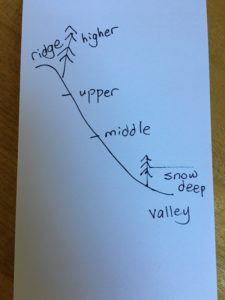Reading for reading tests
In my last article, I talked about general strategies to improve your reading fluency – vocabulary, comprehension, and speed. But the types of reading challenges you face in the Reading section of the TOEFL iBT require additional skills.
Skimming and Scanning
In my classroom reading classes, textbooks often gave students exercises to practice skimming and scanning.
Skimming involves reading through an entire text quickly, looking for the gist or main idea. This is a helpful skill when you are trying to decide whether a particular book or article is pertinent (for example, if you have to write a research paper), but I personally don’t use it with TOEFL articles. I just look at the title and then go straight to the first question. With only 18 minutes per reading task, I assume I’ll understand what the article is about once I go through the questions themselves, and I usually don’t need that information until I get to the final question (two main ideas). Although some teachers and study sites recommend reading the first paragraph and the first sentence of subsequent paragraphs, this isn’t a technique that’s particularly helpful for me, and it definitely takes precious time away from answering the questions.
Scanning means searching for a particular piece of information in a text. This is definitely a helpful skill for the TOEFL. If a particular question asks you about deciduous trees, for example, you will want to quickly scan the paragraph for that word. Proper names (words that are capitalized) and numbers are usually the easiest to spot quickly. Scanning is a skill that we all use in various tasks – whether we’re driving, cooking, cleaning the house, or reading a bus schedule. To improve scanning skills, play a game with a partner. Each of you should have a written text one paragraph long. Each person should find one word in the text and then exchange texts; see which of you can find the word faster.
Intensive Reading
In my last article, I talked about extensive reading – reading lots and lots of material for enjoyment and general understanding. For reading tests, however, you’ll want to focus on intensive reading skills.
When teachers cover intensive reading in a classroom, they usually spend different lessons focusing on specific reading skills, such as figuring out vocabulary words from their context, studying the way different information is presented, identifying the antecedents of pronouns, pinpointing noun-verb relationships, making predictions, and drawing inferences. These are all skills that are needed for the TOEFL iBT.
Can you self-study these types of reading skills? It’s not as easy as engaging in extensive reading. You should consider finding an English tutor, a reading class, or even an academic textbook. I have used both Real Reading (4 levels) and Reading Explorer (6 levels) in my classrooms. You might be able to find less expensive, used copies online. Reading Explorer has been revised, and the first edition of the series is much cheaper and just as good.
And, of course, you can use TOEFL Reading practice tests to hone your intensive reading skills. My preferred method of tutoring for this test is to work through a test with my student, side-by-side. If we work together, I can assess the amount of time they’re taking for each question, identify why they get wrong answers, and explain my own strategies for getting the (hopefully!) right answer.
Let’s see how that would work with a sample test. Here’s a typical TOEFL reading passage (found in TPO 1).
Timberline Vegetation on Mountains
Paragraph 1
The transition from forest to treeless tundra on a mountain slope is often a dramatic one. Within a vertical distance of just a few tens of meters, trees disappear as a life-form and are replaced by low shrubs, herbs, and grasses. This rapid zone of transition is called the upper timberline or tree line. In many semiarid areas there is also a lower timberline where the forest passes into steppe or desert at its lower edge, usually because of a lack of moisture.
Question 1
The word dramatic in the passage is closest in meaning to
- gradual
- complex
- visible
- striking
4. This is a straightforward vocabulary question that ideally my student would be able to answer in a few seconds. Obviously, to do well on a question like this, you would be familiar with the target word and all four choices. The phrases within .. just a few and rapid zone of transition also support the choice of striking.
Question 2
Where is the lower timberline mentioned in paragraph 1 likely to be found?
- In an area that has little water
- In an area that has little sunlight
- Above a transition area
- On a mountain that has an upper timberline.
1. First, you’ll scan quickly to find lower timberline, which is mentioned in the last sentence of the paragraph. To get the right answer, you’ll need to know the word semiarid (semi = partly or half; arid = dry) or else make a well-educated guess from the phrases steppe or desert (they’re usually dry places) or lack of moisture. I would hope that my student would be able to answer this question in less than a minute.
Question 3
Which of the following can be inferred from paragraph 1 about both the upper and lower timberlines?
- Both are treeless zones.
- Both mark forest boundaries.
- Both are surrounded by desert areas.
- Both suffer from a lack of moisture.
2. This question usually takes students longer because they don’t understand what a timberline is. If you’ve ever gone mountain climbing, you’ll remember that sudden transition when you emerge from a forest out into an area with no trees at all. Timber is a word for wood, and a timberline marks that boundary (line) between trees and no trees. The passage itself defines the timberline as tree line. If you know the word boundary, it’s easy to pick Choice 2. But through the process of elimination, you can eliminate the others. Since trees are mentioned, it’s not Choice 1. Deserts are only mentioned for the lower timberline, so it’s not Choice 3. And only the lower timberline suffers from lack of moisture, so we can eliminate Choice 4.
Paragraph 2
The upper timberline, like the snow line, is highest in the tropics and lowest in the Polar Regions. It ranges from sea level in the Polar Regions to 4,500 meters in the dry subtropics and 3,500-4,500 meters in the moist tropics. Timberline trees are normally evergreens, suggesting that these have some advantage over deciduous trees (those that lose their leaves) in the extreme environments of the upper timberline. There are some areas, however, where broadleaf deciduous trees form the timberline. Species of birch, for example, may occur at the timberline in parts of the Himalayas.
Question 4
Paragraph 2 supports which of the following statements about deciduous trees?
- They cannot grow in cold climates.
- They do not exist at the upper timberline.
- They are less likely than evergreens to survive at the upper timberline.
- They do not require as much moisture as evergreens do.
3. First of all, a quick scan through the paragraph to find the word deciduous. TOEFL doesn’t expect you to know that word, so they provide the definition in parentheses. This single sentence should provide you with the answer. Timberline trees are normally (usually) evergreens, not deciduous trees, at the upper timberline. It doesn’t say timberline trees are always evergreens, so Choices 1 and 2 wrong; in fact, the following sentence confirms that some deciduous trees do form the timberline. And there’s nothing about moisture in this paragraph. If you don’t waste your time reading the whole paragraph, and just focus on the one single sentence, you should be able to answer this question quickly.
Paragraph 3
At the upper timberline the trees begin to become twisted and deformed. This is particularly true for trees in the middle and upper latitudes, which tend to attain greater heights on ridges, whereas in the tropics the trees reach their greater heights in the valleys. This is because middle- and upper- latitude timberlines are strongly influenced by the duration and depth of the snow cover. As the snow is deeper and lasts longer in the valleys, trees tend to attain greater heights on the ridges, even though they are more exposed to high-velocity winds and poor, thin soils there. In the tropics, the valleys appear to be more favorable because they are less prone to dry out, they have less frost, and they have deeper soils.
Question 5
The word attain in the passage is closest in meaning to
- require
- resist
- achieve
- endure
3. When answering a question like this, I often substitute my own word in place of the target word before I read the four options. In this case, I thought of trees tend to reach greater heights. Then when I looked at the options, achieve was the obvious choice. Again, this is a relatively easy vocabulary question that students should be able to answer quickly. You don’t need to read the whole paragraph to understand the meaning; just the phrase inside the commas should be enough.
Question 6
The word they in the passage refers to
- valleys
- trees
- heights
- ridges
2. Again, you don’t need to read the whole passage to get the correct answer. Look for the subject of the phrase, trees tend to attain greater heights on the ridges. Heights is the direct object; ridges is the object of a preposition. The subject of the main clause is trees, and therefore it’s most likely that they will be the subject of the dependent clause as well. They, the trees, are what are more exposed to winds and poor soils there on the ridges.
Question 7
The word prone in the passage is closest in meaning to
- adapted
- likely
- difficult
- resistant
2. Another vocabulary question and, in this case, the choice likely came to my mind before I even read the options. I think you should know the word prone, which is commonly used in English. But if not, you could try substituting the other choices. None of them really sounds right.
Question 8
According to paragraph 3, which of the following is true of trees in the middle and upper latitudes?
- Tree growth is negatively affected by the snow cover in valleys
- Tree growth is greater in valleys than on ridges.
- Tree growth on ridges is not affected by high-velocity winds.
- Tree growth lasts longer in those latitudes than it does in the tropics.
1. Unlike most of the questions, this is one where you’ll need to do a close reading of the whole paragraph. What helped me answer this question was a quick little sketch. Don’t be afraid to do this if it helps you create a better picture in your mind. This picture helped me to visualize why snow would be a problem for the trees. My other difficulty was the reading passage’s use of as (in as the snow is deeper and lasts longer …). I usually use as to mean when or during (As I was getting on the bus, I saw a friend) and not as since or because, as it’s used in this passage. This is a question that took me several minutes to be sure of my answer.

Paragraph 4
There is still no universally agreed-on explanation for why there should be such a dramatic cessation of tree growth at the upper timberline. Various environmental factors may play a role. Too much snow, for example, can smother trees, and avalanches and snow creep can damage or destroy them. Late-lying snow reduces the effective growing season to the point where seedlings cannot establish themselves. Wind velocity also increases with altitude and may cause serious stress for trees, as is made evident by the deformed shapes at high altitudes. Some scientists have proposed that the presence of increasing levels of ultraviolet light with elevation may play a role, while browsing and grazing animals like the ibex may be another contributing factor. Probably the most important environmental factor is temperature, for if the growing season is too short and temperatures are too low, tree shoots and buds cannot mature sufficiently to survive the winter months.
Question 9
Which of the sentences below best express the essential information in the highlighted sentence in the passage? Incorrect choices change the meaning in important ways or leave out essential information.
- Because of their deformed shapes at high altitudes, trees are not likely to be seriously harmed by the strong winds typical of those altitudes.
- As altitude increases, the velocity of winds increase, leading to a serious decrease in the number of trees found at high altitudes.
- The deformed shapes of trees at high altitudes show that wind velocity, which increases with altitude, can cause serious hardship for trees.
- Increased wind velocity at high altitudes deforms the shapes of trees, and this may cause serious stress for trees.
3. The good news is that if you already did a close reading of the paragraph, you shouldn’t need to read it carefully again. You only need to look carefully at this one sentence. Try rewording it yourself before looking at the options. Wind is stronger the higher you go; this can stress the trees; you can see this because they’re deformed. Once you do that, you can quickly eliminate the first and second answer. The fourth is not good because it states that the deformed shape causes stress, whereas the text says it’s the wind that stresses the trees. If you are able to paraphrase the original sentence successfully and understand the meaning of the four choices, this should be a relatively quick question to answer. But to do that, you need a good understanding of more complex grammatical structures. One strategy that I recommend is identifying the subject(s), verb(s), direct object(s). For example, in Choice 3, I mentally read:
(the deformed) shapes (of trees at high altitudes) show —> wind velocity (which may increase with altitude) can cause (serious) hardship (for trees).
Question 10
In paragraph 4, what is the author’s main purpose in the discussion of the dramatic cessation of tree growth at the upper timberline?
- To argue that none of several environment factors that are believed to contribute to that phenomenon do in fact play a role in causing it.
- To argue in support of one particular explanation of that phenomenon against several competing explanations
- To explain why the primary environmental factor responsible for that phenomenon has not yet been identified
- To present several environmental factors that may contribute to a satisfactory explanation of that phenomenon
4. My strategy for answering this question relatively rapidly is to skim through the whole paragraph. I see from the first sentence that “there’s no universally agreed-on explanation,” so that sets the stage for a discussion of several explanations. And a quick reading gives me “various environmental factors,” including snow, wind velocity, ultraviolet light, animals, and temperature. These are each mentioned in passing, with only “the most important environmental factor” (temperature) providing a bias toward one explanation. But there’s no other indication that the author or most scientists favor one explanation rather than another. Choice 4 best reflects this reading of the paragraph. Answering this question should be relatively easy, although it will be necessary to at least skim through the whole paragraph rather than focus on only one sentence.
Paragraphs 5 and 6
Above the tree line there is a zone that is generally called alpine tundra. ![]() Immediately adjacent to the timberline, the tundra consists of a fairly complete cover of low-lying shrubs, herbs, and grasses, while higher up the number and diversity of species decrease until there is much bare ground with occasional mosses and lichens and some prostrate cushion plants.
Immediately adjacent to the timberline, the tundra consists of a fairly complete cover of low-lying shrubs, herbs, and grasses, while higher up the number and diversity of species decrease until there is much bare ground with occasional mosses and lichens and some prostrate cushion plants. ![]() Some plants can even survive in favorable microhabitats above the snow line. The highest plants in the world occur at around 6,100 meters on Makalu in the Himalayas.
Some plants can even survive in favorable microhabitats above the snow line. The highest plants in the world occur at around 6,100 meters on Makalu in the Himalayas. ![]() At this great height, rocks, warmed by the sun, melt small snowdrifts.
At this great height, rocks, warmed by the sun, melt small snowdrifts. ![]()
The most striking characteristic of the plants of the alpine zone is their low growth form. This enables them to avoid the worst rigors of high winds and permits them to make use of the higher temperatures immediately adjacent to the ground surface. In an area where low temperatures are limiting to life, the importance of the additional heat near the surface is crucial. The low growth form can also permit the plants to take advantage of the insulation provided by a winter snow cover. In the equatorial mountains the low growth form is less prevalent.
Question 11
The word prevalent in the passage is closest in meaning to
- predictable
- widespread
- successful
- developed
2. Yet another vocabulary question which should be quickly and easily answered if you know the target word. My substitute word was common, and widespread is a synonym of that. It is interesting to me that the first two words, dramatic and attain, appear on the Academic Word List, while the second two, prone and prevalent, do not. This indicates to me that while it’s certainly a good idea to study vocabulary words from a well-recognized word list, extensive reading from a variety of sources is essential as well. Not all the words you need will be found on a single list.
Question 12
According to paragraph 6, all of the following statements are true of plants in the alpine zone EXCEPT:
- Because they are low, they are less exposed to strong winds.
- Because they are low, the winter snow cover gives them more protection from the extreme cold.
- In the equatorial mountains, they tend to be lower than in mountains elsewhere.
- Their low growth form keeps them closer to the ground, where there is more heat than further up.
3. Questions like this always confuse me and I have to keep in mind what they’re really asking, that is … which of these statements is FALSE! Again, I have to make a quick skim of the whole paragraph, focusing on the important words; phrases like avoid high winds, make use of higher temperatures [near] the ground, insulation by snow all mirror Choices 1, 2, and 4. To make sure the statement in Choice 3 is false, I closely read the last sentence in the paragraph (the only one that mentions equatorial mountains). It doesn’t say anything about the low growth form being lower, just less prevalent. Even if I didn’t know what prevalent meant, I would choose that option anyway, because the other three choices all seem true to me.
Question 13
Look at the four squares [ ![]() ] that indicate where the following sentence could be added to the passage.
] that indicate where the following sentence could be added to the passage.
This explains how, for example, alpine cushion plants have been found growing at an altitude of 6,180 meters.
Where would the sentence best fit? Click on a square to add the sentence to the passage.
4. I hate this kind of question! What I will do, before reading the paragraph, is to look closely at the sentence itself. This explains how [some sort of explanation needs to precede this sentence] … for example, alpine cushion plants [since this is an example, alpine cushion plants probably haven’t already been mentioned] have been found growing at an altitude of 6,180 meters [this is a high altitude]. Now I’ll go back, read through the whole paragraph, and see where that information might fit best. Choice 1 makes no sense; the preceding sentence describes a situation, not an explanation. Choice 2? Oops, they mention cushion plants, so that destroys my hypothesis but the plants are prostrate. I need to know that vocabulary word to make sense of the passage: it means to be lying face down, in a position of weakness. But it doesn’t make sense to follow that mention of cushion plants with another mention of cushion plants as an example. Reading on, I get to Choice 3, but the preceding sentence isn’t an explanation, so the sentence doesn’t fit. And now, Choice 4 … this had better be the right one since I’ve eliminated the others. It indicates that we’re at a great height (as the sentence said) and that rocks are hot enough to melt the snow. Thus, the presence of these hot rocks explains why some cushion plants can thrive here in this microclimate, even when they were prostrate further down the mountain.
Question 14
An introductory sentence for a brief summary of the passage is provided below. Complete the summary by selecting the THREE answer choices that express the most important ideas in the passage. Some sentences do not belong in the summary because they express ideas that are not presented in the passage or are minor ideas in the passage.
At the timberline, whether upper or lower, there is a profound change in the growth of trees and other plants.
- Birch is one of the few species of tree that can survive in the extreme environments of the upper timberline.
- The temperature at the upper timberline is probably more important in preventing tree growth than factors such as the amount of snowfall or the force of winds.
- High levels of ultraviolet light most likely play a greater role in determining tree growth at the upper timberline than do grazing animals such as the ibex.
- There is no agreement among scientists as to exactly why plant growth is sharply different above and below the upper timberline.
- The geographical location of an upper timberline has an impact on both the types of trees found there and their physical characteristics.
- Despite being adjacent to the timberline, the alpine tundra is an area where certain kinds of low trees can endure high winds and very low temperatures.
2, 4, 5. By the time you get ready to answer this final question, you should have a good sense of the whole reading passage, even though you didn’t read it word for word. Three choices are right, and three choices are wrong. Therefore, we should use two strategies together … identifying those statements that are minor details or not true or both, and those statements that seem to accurately reflect main ideas in the text. With this method, I quickly eliminate Choice 1 (minor detail in Paragraph 2) and Choice 3 (minor detail in Paragraph 4, and not true either).
With that being said, I don’t agree with the answers given in my TPO app (they say 4, 5, and 6), so either they’ve made a mistake, or I have. I picked Choice 2 because a whole paragraph (4) is devoted to factors affecting tree growth, and it’s stated that “the most important environmental factor is temperature.” I picked Choice 4 because we know plant growth is sharply different (dramatically different!) and aren’t given one definitive explanation for it. And Choice 5 was an obvious choice; the text mentioned various geographical locations and the differences associated with them. I rejected Choice 6 because the very first sentence mentioned the “treeless tundra” and although two paragraphs discuss the tundra, there is no mention of trees there, just shrubs, herbs, and grasses.
The final question counts two points, so spend a bit of time on it. Even if you don’t get all three choices correct, at least try to eliminate a couple and make your best guess on the remaining ones.
General Advice
Hopefully, the section above has given you an idea of how I approach a reading passage on the TOEFL and its associated questions. In terms of overall strategies, I recommend:
- Watch your time. Mentally divide your time into 18-minute segments and don’t take longer than 18 minutes on any one section. You can always go back if you have remaining time at the end.
- Answer every question. You don’t lose points for wrong answers.
- Expect that some questions can be answered really quickly and some more slowly. Don’t panic if you hit a tough one.
- If you are really stumped for an answer, at least eliminate one or two choices that are obviously wrong and then make your best guess.
- Use scanning to quickly locate the information you need. As you can see from the questions above, many could be answered by looking at just a single sentence.
- Although many websites and teachers recommend skimming the whole passage at the beginning, I don’t. I think it’s a waste of time. Reading the title is enough. You’ll never have enough time to read the whole article carefully, so don’t even try. By working through each question, you should have a fairly good understanding of the whole passage by the time you get to the last question.
- Be careful! To throw test takers off, test writers use “distractors” by including a word or phrase from the passage. You can see that in Choice 3 of Question 12.
Although TOEFL Reading is a challenging test, I believe it’s a fairly good tool to assess reading ability. These are skills that you’ll need for the future when you tackle academic texts in English. Reading skills won’t improve overnight, but with steady, sustained work including vocabulary acquisition, extensive reading, speed reading, intensive reading, and TOEFL-specific practice, you should get your goal score sooner or later.
Edited to add: With the “new” shorter TOEFL iBT, there are fewer questions per reading section than in the TPO practice tests. However, the same question types have been retained. If there are any further revisions to the test, just remember to take your total reading time, divide it by the number of reading passages, and use that time per reading passage to determine your progress through the test. Timing is critical; every question should be answered!




